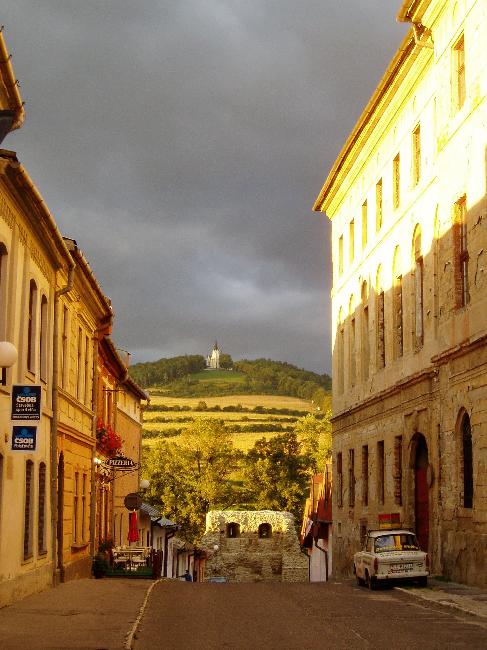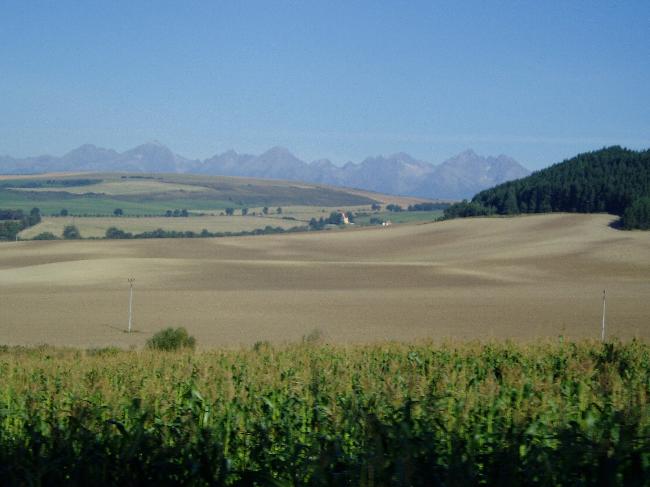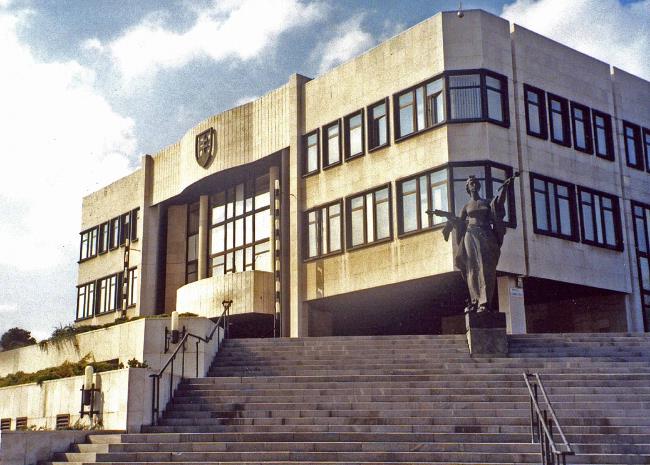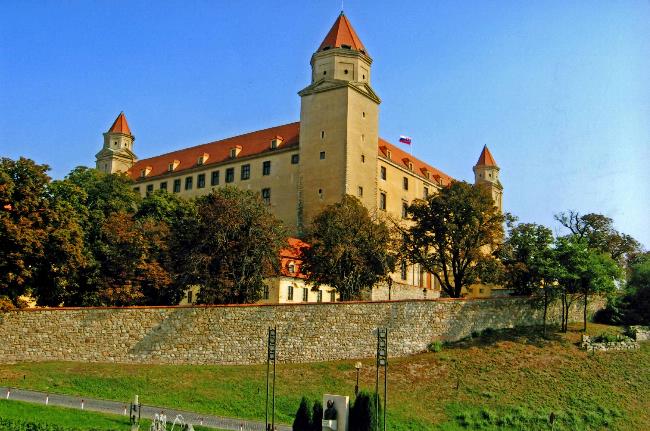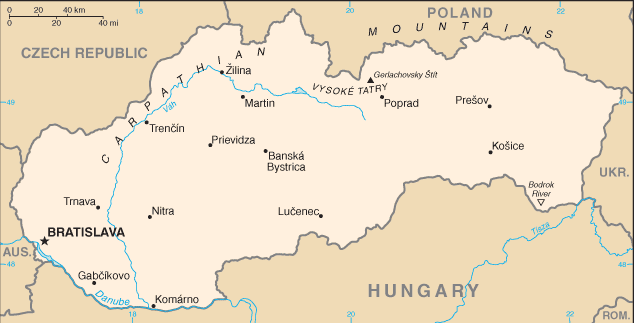Introduction :: SLOVAKIA
-
Slovakia's roots can be traced to the 9th century state of Great Moravia. Subsequently, the Slovaks became part of the Hungarian Kingdom, where they remained for the next 1,000 years. Following the formation of the dual Austro-Hungarian monarchy in 1867, language and education policies favoring the use of Hungarian (Magyarization) resulted in a strengthening of Slovak nationalism and a cultivation of cultural ties with the closely related Czechs, who were under Austrian rule. After the dissolution of the Austro-Hungarian Empire at the close of World War I, the Slovaks joined the Czechs to form Czechoslovakia. During the interwar period, Slovak nationalist leaders pushed for autonomy within Czechoslovakia, and in 1939 Slovakia became an independent state allied with Nazi Germany. Following World War II, Czechoslovakia was reconstituted and came under communist rule within Soviet-dominated Eastern Europe. In 1968, an invasion by Warsaw Pact troops ended the efforts of the country's leaders to liberalize communist rule and create "socialism with a human face," ushering in a period of repression known as "normalization." The peaceful "Velvet Revolution" swept the Communist Party from power at the end of 1989 and inaugurated a return to democratic rule and a market economy. On 1 January 1993, the country underwent a nonviolent "velvet divorce" into its two national components, Slovakia and the Czech Republic. Slovakia joined both NATO and the EU in the spring of 2004 and the euro zone on 1 January 2009.
Geography :: SLOVAKIA
-
Central Europe, south of Poland
48 40 N, 19 30 E
Europe
total: 49,035 sq km
land: 48,105 sq km
water: 930 sq km
country comparison to the world: 131
about twice the size of New Hampshire
total: 1,611 km
border countries (5): Austria 105 km, Czech Republic 241 km, Hungary 627 km, Poland 541 km, Ukraine 97 km
0 km (landlocked)
none (landlocked)
temperate; cool summers; cold, cloudy, humid winters
rugged mountains in the central and northern part and lowlands in the south
mean elevation: 458 m
elevation extremes: lowest point: Bodrok River 94 m
highest point: Gerlachovsky Stit 2,655 m
lignite, small amounts of iron ore, copper and manganese ore; salt; arable land
agricultural land: 40.1%
arable land 28.9%; permanent crops 0.4%; permanent pasture 10.8%
forest: 40.2%
other: 19.7% (2011 est.)
869 sq km (2012)
a fairly even distribution throughout most of the country; slightly larger concentration in the west in proximity to the Czech border
NA
air pollution from metallurgical plants presents human health risks; acid rain damaging forests
party to: Air Pollution, Air Pollution-Nitrogen Oxides, Air Pollution-Persistent Organic Pollutants, Air Pollution-Sulfur 85, Air Pollution-Sulfur 94, Air Pollution-Volatile Organic Compounds, Antarctic Treaty, Biodiversity, Climate Change, Climate Change-Kyoto Protocol, Desertification, Endangered Species, Environmental Modification, Hazardous Wastes, Law of the Sea, Ozone Layer Protection, Ship Pollution, Wetlands, Whaling
signed, but not ratified: none of the selected agreements
landlocked; most of the country is rugged and mountainous; the Tatra Mountains in the north are interspersed with many scenic lakes and valleys
People and Society :: SLOVAKIA
-
5,445,802 (July 2016 est.)
country comparison to the world: 119
noun: Slovak(s)
adjective: Slovak
Slovak 80.7%, Hungarian 8.5%, Roma 2%, other and unspecified 8.8% (2011 est.)
Slovak (official) 78.6%, Hungarian 9.4%, Roma 2.3%, Ruthenian 1%, other or unspecified 8.8% (2011 est.)
Roman Catholic 62%, Protestant 8.2%, Greek Catholic 3.8%, other or unspecified 12.5%, none 13.4% (2011 est.)
0-14 years: 15.14% (male 422,797/female 401,718)
15-24 years: 11.32% (male 317,775/female 298,954)
25-54 years: 45.13% (male 1,241,212/female 1,216,596)
55-64 years: 13.52% (male 349,089/female 387,394)
65 years and over: 14.88% (male 312,042/female 498,225) (2016 est.)
population pyramid:

Europe
::SLOVAKIA

Population Pyramid
A population pyramid illustrates the age and sex structure of a country's population and may provide insights about political and social stability, as well as economic development. The population is distributed along the horizontal axis, with males shown on the left and females on the right. The male and female populations are broken down into 5-year age groups represented as horizontal bars along the vertical axis, with the youngest age groups at the bottom and the oldest at the top. The shape of the population pyramid gradually evolves over time based on fertility, mortality, and international migration trends.
For additional information, please see the entry for Population pyramid on the Definitions and Notes page under the References tab.
total dependency ratio: 40.8%
youth dependency ratio: 21.3%
elderly dependency ratio: 19.5%
potential support ratio: 5.1% (2015 est.)
total: 40.1 years
male: 38.4 years
female: 41.9 years (2016 est.)
country comparison to the world: 49
0.01% (2016 est.)
country comparison to the world: 195
9.8 births/1,000 population (2016 est.)
country comparison to the world: 198
9.8 deaths/1,000 population (2016 est.)
country comparison to the world: 47
0.1 migrant(s)/1,000 population (2016 est.)
country comparison to the world: 71
a fairly even distribution throughout most of the country; slightly larger concentration in the west in proximity to the Czech border
urban population: 53.6% of total population (2015)
rate of urbanization: -0.31% annual rate of change (2010-15 est.)
BRATISLAVA (capital) 401,000 (2015)
at birth: 1.07 male(s)/female
0-14 years: 1.05 male(s)/female
15-24 years: 1.06 male(s)/female
25-54 years: 1.02 male(s)/female
55-64 years: 0.9 male(s)/female
65 years and over: 0.62 male(s)/female
total population: 0.94 male(s)/female (2016 est.)
27.4 (2013 est.)
6 deaths/100,000 live births (2015 est.)
country comparison to the world: 172
total: 5.2 deaths/1,000 live births
male: 5.8 deaths/1,000 live births
female: 4.5 deaths/1,000 live births (2016 est.)
country comparison to the world: 176
total population: 77.1 years
male: 73.5 years
female: 80.9 years (2016 est.)
country comparison to the world: 76
1.4 children born/woman (2016 est.)
country comparison to the world: 211
8.1% of GDP (2014)
country comparison to the world: 62
3.32 physicians/1,000 population (2012)
6 beds/1,000 population (2011)
improved:
urban: 100% of population
rural: 100% of population
total: 100% of population
unimproved:
urban: 0% of population
rural: 0% of population
total: 0% of population (2015 est.)
improved:
urban: 99.4% of population
rural: 98.2% of population
total: 98.8% of population
unimproved:
urban: 0.6% of population
rural: 1.8% of population
total: 1.2% of population (2015 est.)
0.02% (2014 est.)
country comparison to the world: 129
NA
less than 100 (2014 est.)
country comparison to the world: 116
27.4% (2014)
country comparison to the world: 54
4.1% of GDP (2013)
country comparison to the world: 103
total: 15 years
male: 14 years
female: 16 years (2014)
total: 29.7%
male: 29.5%
female: 30.1% (2014 est.)
country comparison to the world: 21
Government :: SLOVAKIA
-
conventional long form: Slovak Republic
conventional short form: Slovakia
local long form: Slovenska republika
local short form: Slovensko
etymology: related to the Slavic autonym (self-designation) "Slovenin," a derivation from "slovo" (word), denoting "people who speak (the same language)" (i.e., people who understand each other)
parliamentary republic
name: Bratislava
geographic coordinates: 48 09 N, 17 07 E
time difference: UTC+1 (6 hours ahead of Washington, DC,. during Standard Time)
daylight saving time: +1hr, begins last Sunday in March; ends last Sunday in October
8 regions (kraje, singular - kraj); Banskobystricky, Bratislavsky, Kosicky, Nitriansky, Presovsky, Trenciansky, Trnavsky, Zilinsky
1 January 1993 (Czechoslovakia split into the Czech Republic and Slovakia)
Constitution Day, 1 September (1992)
history: several previous (preindependence); latest passed by the National Council 1 September 1992, signed 3 September 1992, effective 1 October 1992
amendments: proposed by the National Council; passage requires at least three-fifths majority vote of Council members; amended many times, last in 2015 (2016)
civil law system based on Austro-Hungarian codes; note - legal code modified to comply with the obligations of Organization on Security and Cooperation in Europe
accepts compulsory ICJ jurisdiction with reservations; accepts ICCt jurisdiction
citizenship by birth: no
citizenship by descent only: at least one parent must be a citizen of Slovakia
dual citizenship recognized: no
residency requirement for naturalization: 5 years
18 years of age; universal
chief of state: President Andrej KISKA (since 15 June 2014)
head of government: Prime Minister Robert FICO (since 4 April 2012); Deputy Prime Ministers Robert KALINAK, Peter KAZIMIR, Miroslav LAJCAK (since 4 April 2012), Lubomir VAZNY (since 26 November 2012)
cabinet: Cabinet appointed by the president on the recommendation of the prime minister
elections/appointments: president directly elected by absolute majority popular vote in 2 rounds if needed for a 5-year term (eligible for a second term); election last held in 2 rounds on 15 and 29 March 2014 (next to be held in March 2019); following National Council elections, the leader of the majority party or majority coalition usually appointed prime minister by the president
election results: Andrej KISKA elected president; percent of vote in second round - Andrej KISKA (independent) 59.4%, Robert FICO (Smer-SD) 40.6%
description: unicameral National Council or Narodna Rada (150 seats; members directly elected in a single national constituency by proportional representation vote; members serve 4-year terms)
elections: last held on 5 March 2016 (next to be held in March 2020)
election results: percent of vote by party - Smer-SD 28.3%, SaS 12.1%, OLaNO-NOVA 11%, SNS 8.6%, LSNS 8%, SME-Rodina 6.6%, Most-Hid 6.5%, Siet 5.6%, other 13.3%; seats by party - Smer-SD 49, SaS 21, OLaNO-NOVA 19, SNS 15, LSNS 14, SME-Rodina 11, Most-Hid 11, Siet 10
highest court(s): Supreme Court of the Slovak Republic (consists of the court president, vice president, and 84 judges organized into criminal, civil, commercial, and administrative divisions with 3- and 5-judge panels); Constitutional Court (consists of 13 judges)
judge selection and term of office: Supreme Court judge candidates proposed by the Judicial Council of the Slovak Republic, a 17-member independent body to include the Supreme Court chief justice and presidential and governmental appointees; judges appointed by the president for life with mandatory retirement at age 65; Constitutional Court judges nominated by the National Council of the Republic and appointed by the president; judges appointed for 12-year terms
subordinate courts: regional and district civil courts; Higher Military Court; military district courts; Court of Audit
parties in the Parliament:
Direction-Social Democracy or Smer-SD [Robert FICO]
Bridge or Most-Hid [Bela BUGAR]
Freedom and Solidarity or SaS [Richard SULIK]
Network or Siet [Radoslav PROCHAZKA]
Ordinary People and Independent Personalities - New Majority or OLaNO-NOVA [Igor MATOVIC]
People's Party - Our Slovakia or LSNS [Marian KOTLEBA]
Slovak National Party or SNS [Andrej DANKO]
We Are Family or SME-Rodina [Boris KOLLAR]
selected parties outside the Parliament:
Christian Democratic Movement or KDH [Jan FIGEL]
JUMP! or SKOK! [Juraj MISKOV]
Party of the Hungarian Coalition or SMK [Jozsef BERENYI]
Slovak Democratic and Christian Union-Democratic Party or SDKU-DS [Pavol FRESO]
Alliance of Companies Employing 500 or More Employees or Klub500
Association of Towns and Villages or ZMOS
Confederation of Trade Unions or KOZ
Entrepreneurs Association of Slovakia or ZPS
Federation of Employers' Associations of the Slovak Republic or AZZZ
Medical Trade Association or LOZ
National Union of Employers or RUZ
Slovak Chamber of Commerce and Industry or SOPK
The Business Alliance of Slovakia or PAS
Australia Group, BIS, BSEC (observer), CBSS (observer), CD, CE, CEI, CERN, EAPC, EBRD, ECB, EIB, EMU, EU, FAO, IAEA, IBRD, ICAO, ICC (national committees), ICRM, IDA, IEA, IFC, IFRCS, ILO, IMF, IMO, IMSO, Interpol, IOC, IOM, IPU, ISO, ITU, ITUC (NGOs), MIGA, NATO, NEA, NSG, OAS (observer), OECD, OIF (observer), OPCW, OSCE, PCA, Schengen Convention, SELEC (observer), UN, UNCTAD, UNESCO, UNFICYP, UNIDO, UNTSO, UNWTO, UPU, WCO, WFTU (NGOs), WHO, WIPO, WMO, WTO, ZC
chief of mission: Ambassador Peter KMEC (since 17 September 2012)
chancery: 3523 International Court NW, Washington, DC 20008
telephone: [1] (202) 237-1054
FAX: [1] (202) 237-6438
consulate(s) general: Los Angeles, New York
chief of mission: Charge d’Affaires J. Liam WASLEY (since September 2015)
embassy: Hviezdoslavovo Namestie 4, 81102 Bratislava
mailing address: P.O. Box 309, 814 99 Bratislava
telephone: [421] (2) 5443-3338
FAX: [421] (2) 5441-8861
three equal horizontal bands of white (top), blue, and red derive from the Pan-Slav colors; the Slovakian coat of arms (consisting of a red shield bordered in white and bearing a white double-barred cross of St. Cyril and St. Methodius surmounting three blue hills) is centered over the bands but offset slightly to the hoist side
note: the Pan-Slav colors were inspired by the 19th-century flag of Russia
double-barred cross (Cross of St. Cyril and St. Methodius) surmounting three peaks; national colors: white, blue, red
name: "Nad Tatrou sa blyska" (Lightning Over the Tatras)
lyrics/music: Janko MATUSKA/traditional
note: adopted 1993, in use since 1844; music based on the Slovak folk song "Kopala studienku"
Economy :: SLOVAKIA
-
Slovakia has made significant economic reforms since its separation from the Czech Republic in 1993. With a population of 5.4 million, the Slovak Republic has a small, open economy, with exports, at about 93% of GDP, serving as the main driver of GDP growth. Slovakia joined the EU in 2004 and the euro zone in 2009. The country’s banking sector is sound.
Slovakia has led the region garnering FDI, because of its relatively low-cost, highly-skilled labor force, reasonable tax rates, and favorable geographic location in the heart of Central Europe. However, recent increases in corporate taxes, as well as changes to the Labor Code, slow dispute resolution, and ongoing corruption potentially threaten the attractiveness of the Slovak market. Moreover, the energy sector is characterized by high costs, unpredictable regulatory oversight, and growing government interference.
$169.1 billion (2016 est.)
$163.4 billion (2015 est.)
$157.8 billion (2014 est.)
note: data are in 2016 dollars
country comparison to the world: 71
$90.26 billion (2015 est.)
3.4% (2016 est.)
3.6% (2015 est.)
2.5% (2014 est.)
country comparison to the world: 81
$31,200 (2016 est.)
$30,200 (2015 est.)
$29,100 (2014 est.)
note: data are in 2016 dollars
country comparison to the world: 61
21.8% of GDP (2016 est.)
21.6% of GDP (2015 est.)
21.1% of GDP (2014 est.)
country comparison to the world: 71
household consumption: 55.9%
government consumption: 18.9%
investment in fixed capital: 22.2%
investment in inventories: -0.2%
exports of goods and services: 94.8%
imports of goods and services: -91.6% (2016 est.)
agriculture: 3.6%
industry: 31.6%
services: 64.8% (2016 est.)
grains, potatoes, sugar beets, hops, fruit; pigs, cattle, poultry; forest products
automobiles; metal and metal products; electricity, gas, coke, oil, nuclear fuel; chemicals, synthetic fibers, wood and paper products; machinery; earthenware and ceramics; textiles; electrical and optical apparatus; rubber products; food and beverages; p
4.3% (2016 est.)
country comparison to the world: 48
2.724 million (2016 est.)
country comparison to the world: 109
agriculture: 4.2%
industry: 22.6%
services: 73.2% (2015)
9.8% (2016 est.)
11.5% (2015 est.)
country comparison to the world: 115
12.6% (2014 est.)
lowest 10%: 4.4%
highest 10%: 26% (2013 est.)
26 (2013)
25.7 (2011)
country comparison to the world: 138
revenues: $34.87 billion
expenditures: $37.04 billion (2016 est.)
38.6% of GDP (2016 est.)
country comparison to the world: 42
-2.4% of GDP (2016 est.)
country comparison to the world: 79
52.4% of GDP (2016 est.)
52.9% of GDP (2015 est.)
note: data cover general Government Gross Debt, and includes debt instruments issued (or owned) by Government entities, including sub-sectors of central government, state government, local government, and social security funds
country comparison to the world: 82
calendar year
-0.3% (2016 est.)
-0.3% (2015 est.)
country comparison to the world: 21
0.05% (9 December 2015)
0.05% (10 September 2014)
note: this is the European Central Bank's rate on the marginal lending facility, which offers overnight credit to banks from the euro area; Slovakia became a member of the Economic and Monetary Union (EMU) on 1 January 2009
country comparison to the world: 141
2.7% (31 December 2016 est.)
2.78% (31 December 2015 est.)
country comparison to the world: 170
$42.43 billion (31 December 2016 est.)
$43 billion (31 December 2015 est.)
note: see entry for the European Union for money supply for the entire euro area; the European Central Bank (ECB) controls monetary policy for the 18 members of the Economic and Monetary Union (EMU); individual members of the EMU do not control the quantity of
country comparison to the world: 54
$58.76 billion (31 December 2016 est.)
$58.41 billion (31 December 2015 est.)
country comparison to the world: 64
$66.15 billion (31 December 2016 est.)
$67.67 billion (31 December 2015 est.)
country comparison to the world: 59
$4.634 billion (31 December 2015 est.)
$4.732 billion (31 December 2014 est.)
$4.801 billion (31 December 2013 est.)
country comparison to the world: 85
-$885 million (2016 est.)
-$1.128 billion (2015 est.)
country comparison to the world: 119
$74.35 billion (2016 est.)
$73.12 billion (2015 est.)
country comparison to the world: 40
vehicles and related parts 27%, machinery and electrical equipment 20%, nuclear reactors and furnaces 12%, iron and steel 4%, mineral oils and fuels 5% (2015 est.)
Germany 22.7%, Czech Republic 12.5%, Poland 8.5%, Austria 5.7%, Hungary 5.7%, France 5.6%, UK 5.5%, Italy 4.5% (2015)
$71.47 billion (2016 est.)
$71.09 billion (2015 est.)
country comparison to the world: 39
machinery and electrical equipment 20%, vehicles and related parts 14%, nuclear reactors and furnaces 12%, fuel and mineral oils 9% (2015 est.)
Germany 19.4%, Czech Republic 17.4%, Austria 9.1%, Hungary 6.3%, Poland 6.3%, South Korea 5.5%, Russia 5.2%, China 4.1% (2015)
$2.657 billion (31 December 2016 est.)
$2.892 billion (31 December 2015 est.)
country comparison to the world: 107
$75.04 billion (31 March 2016 est.)
$74.19 billion (31 March 2015 est.)
country comparison to the world: 56
$59.81 billion (31 December 2016 est.)
$56.31 billion (31 December 2015 est.)
country comparison to the world: 56
$12.11 billion (31 December 2016 est.)
$10.71 billion (31 December 2015 est.)
country comparison to the world: 59
euros (EUR) per US dollar -
0.9214 (2016 est.)
0.885 (2015 est.)
0.885 (2014 est.)
0.7634 (2013 est.)
0.7752 (2012 est.)
Energy :: SLOVAKIA
-
27.25 billion kWh (2014 est.)
country comparison to the world: 68
28.36 billion kWh (2014 est.)
country comparison to the world: 63
11.86 billion kWh (2014 est.)
country comparison to the world: 19
12.96 billion kWh (2014 est.)
country comparison to the world: 18
8.076 million kW (2014 est.)
country comparison to the world: 70
33.2% of total installed capacity (2014 est.)
country comparison to the world: 174
24% of total installed capacity (2014 est.)
country comparison to the world: 8
31.4% of total installed capacity (2014 est.)
country comparison to the world: 72
11.2% of total installed capacity (2014 est.)
country comparison to the world: 29
200 bbl/day (2015 est.)
country comparison to the world: 96
501.5 bbl/day (2015 est.)
country comparison to the world: 85
119,200 bbl/day (2015 est.)
country comparison to the world: 41
9 million bbl (1 January 2016 es)
country comparison to the world: 94
142,500 bbl/day (2015 est.)
country comparison to the world: 62
82,620 bbl/day (2015 est.)
country comparison to the world: 87
83,390 bbl/day (2015 est.)
country comparison to the world: 49
28,870 bbl/day (2015 est.)
country comparison to the world: 100
100 million cu m (2014 est.)
country comparison to the world: 81
4.535 billion cu m (2014 est.)
country comparison to the world: 60
3 million cu m (2014 est.)
country comparison to the world: 52
4.757 billion cu m (2014 est.)
country comparison to the world: 33
14.16 billion cu m (1 January 2016 es)
country comparison to the world: 78
33 million Mt (2013 est.)
country comparison to the world: 75
Communications :: SLOVAKIA
-
total subscriptions: 866,630
subscriptions per 100 inhabitants: 16 (July 2015 est.)
country comparison to the world: 80
total: 6.676 million
subscriptions per 100 inhabitants: 123 (July 2015 est.)
country comparison to the world: 108
general assessment: a modern telecommunications system that has expanded dramatically in recent years with the growth of cellular services
domestic: analog system is now receiving digital equipment and is being enlarged with fiber-optic cable, especially in the larger cities; 3 companies provide nationwide cellular services
international: country code - 421; 3 international exchanges (1 in Bratislava and 2 in Banska Bystrica) are available; Slovakia is participating in several international telecommunications projects that will increase the availability of external services (2011)
state-owned public broadcaster, Radio and Television of Slovakia (RTVS), operates 2 national TV stations and multiple national and regional radio networks; roughly 50 privately owned TV stations operating nationally, regionally, and locally; about 40% of (2016)
.sk
total: 4.629 million
percent of population: 85% (July 2015 est.)
country comparison to the world: 72
Transportation :: SLOVAKIA
-
number of registered air carriers: 4
inventory of registered aircraft operated by air carriers: 23
annual passenger traffic on registered air carriers: 11,100
annual freight traffic on registered air carriers: 0 mt-km (2015)
OM (2016)
35 (2013)
country comparison to the world: 111
total: 21
over 3,047 m: 2
2,438 to 3,047 m: 2
1,524 to 2,437 m: 3
914 to 1,523 m: 3
under 914 m: 11 (2013)
total: 14
914 to 1,523 m: 9
under 914 m: 5 (2013)
1 (2013)
gas 6,774 km; oil 419 km (2013)
total: 3,624 km
broad gauge: 99 km 1.520-m gauge
standard gauge: 3,475 km 1.435-m gauge (1,616 km electrified)
narrow gauge: 50 km 1.000-m or 0.750-m gauge (2014)
country comparison to the world: 49
total: 54,869 km (includes local roads, national roads, and 420 km of highways) (2012)
country comparison to the world: 75
172 km (on Danube River) (2012)
country comparison to the world: 99
total: 11
by type: cargo 9, refrigerated cargo 2
foreign-owned: 11 (Germany 3, Ireland 1, Italy 2, Montenegro 1, Slovenia 1, Turkey 1, Ukraine 2) (2010)
country comparison to the world: 112
river port(s): Bratislava, Komarno (Danube)
Military and Security :: SLOVAKIA
-
Armed Forces of the Slovak Republic (Ozbrojene Sily Slovenskej Republiky): Land Forces (Pozemne Sily), Air Forces (Vzdusne Sily) (2010)
18-30 years of age for voluntary military service; conscription in peacetime suspended in 2006; women are eligible to serve (2012)
1.03% of GDP (2015)
1.01% of GDP (2014)
1% of GDP (2013)
1.12% of GDP (2012)
1.1% of GDP (2011)
country comparison to the world: 89
Transnational Issues :: SLOVAKIA
-
bilateral government, legal, technical and economic working group negotiations continued in 2006 between Slovakia and Hungary over Hungary's completion of its portion of the Gabcikovo-Nagymaros hydroelectric dam project along the Danube; as a member state that forms part of the EU's external border, Slovakia has implemented the strict Schengen border rules
stateless persons: 1,523 (2015)
transshipment point for Southwest Asian heroin bound for Western Europe; producer of synthetic drugs for regional market; consumer of ecstasy










